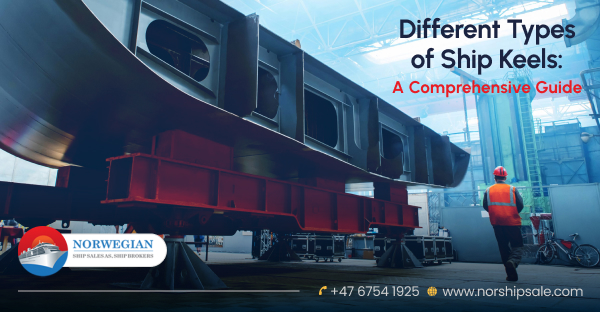A ship’s keel is similar to a human’s spinal cord. Just like our spine helps our backbone to stay upright and supports our body, the keel works as the backbone of the ship. This component runs longitudinally along the bottom plate’s centerline surrounding which the ship’s hull is built. Every other component of the ship is connected either directly or indirectly to this structural member of the ship. So, a ship owner or a buyer needs to know about the ship’s keel. Should you be someone who lives in Norway, and is planning to buy a good ship for sale in Norway, this blog can help you to make the best decision.

Flat Keel
Flat Keel is a plate that the frames, which are located around the ship support. It is solid and comparatively thicker than the other plates. It must have a uniform thickness for 3/5th length. Towards the end, this plate may gradually decrease in thickness, which is common in the majority of vessels today. This keel may be fitted with the single or double bottom hull.
Duct Keel
The ships with double bottom hulls are provided with duct keels and these keels comprises of solid plates that are welded in the shape of a box. This forms an internal watertight passage that runs parallel to the ship’s length, which is from the collision bulkhead to the bulkhead of the forward engine room. This keel is created by two longitudinal girders, that must be1.83m apart from each other. This distance should not be increased as the girders should stay supported by the keel blocs during docking. The brackets generally stay on the keel and between the girders of the inner bottom plating.
Some advantages of duct keels.
- Duct keels have higher strength in comparison to other keel types. This is because this keel offers great resistance to loads because of the box structure it has.
- It enables protected cables, ballast and bunker pipelines, to run before, after and beneath the spaces of the cargo. This lets the pipelines get inspected easily when the cargo is loaded.
- In this duct, it is possible to pass the water pipes and oil to prevent any kind of contamination that would have been possible if the pipes were passed via the cargo tanks.
Bar Keel
Bar steel is heavier and stronger than the flat keel. The bar keel is made of a steel bar that is flat and or a plate made of steel. You will find a steel bar at this keel’s centre. This keel consists of a bar that is supported by the frames, which run around the ship. However, this was used when ships started to being built with the help of steel and not wood. And, these keels are mostly found on the hulls with a single bottom that is supported by solid floors maybe with a keelson plate or without it. This type of bar keel is not commonly seen in the new ships since they do not extend enough support to large ships because no direct connection is there between the floors and the keel. This is why flat keels are now used in big vessels in place of bar keels. However, you can find them with ferries, boats, and tugs, which face more risks when grounding.
So, now that you know about the different types of keels and why they are important, you know how important it is to check the keel before buying a ship. In case you live in Norway and want to buy a ship sale in Norway then you must contact a good shipbroker.
Conclusion
Keel are important parts of a ship, therefore, it is important to pay attention to them. In fact, people who want to buy a ship should know the keels and buy the ship after proper inspection. Thus, it is best to contact a shipbroker when buying a ship. So, if you live in Norway and thinking of buying a ship for sale in Norway, make sure to get in touch with a reliable shipbroker.

